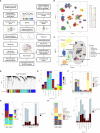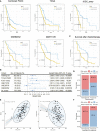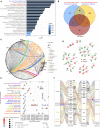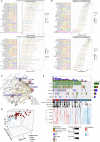Gene Coexpression Network Characterizing Microenvironmental Heterogeneity and Intercellular Communication in Pancreatic Ductal Adenocarcinoma: Implications of Prognostic Significance and Therapeutic Target
- PMID: 35719923
- PMCID: PMC9198606
- DOI: 10.3389/fonc.2022.840474
Gene Coexpression Network Characterizing Microenvironmental Heterogeneity and Intercellular Communication in Pancreatic Ductal Adenocarcinoma: Implications of Prognostic Significance and Therapeutic Target
Abstract
Background: Pancreatic ductal adenocarcinoma (PDAC) is characterized by intensive stromal involvement and heterogeneity. Pancreatic cancer cells interact with the surrounding tumor microenvironment (TME), leading to tumor development, unfavorable prognosis, and therapy resistance. Herein, we aim to clarify a gene network indicative of TME features and find a vulnerability for combating pancreatic cancer.
Methods: Single-cell RNA sequencing data processed by the Seurat package were used to retrieve cell component marker genes (CCMGs). The correlation networks/modules of CCMGs were determined by WGCNA. Neural network and risk score models were constructed for prognosis prediction. Cell-cell communication analysis was achieved by NATMI software. The effect of the ITGA2 inhibitor was evaluated in vivo by using a KrasG12D -driven murine pancreatic cancer model.
Results: WGCNA categorized CCMGs into eight gene coexpression networks. TME genes derived from the significant networks were able to stratify PDAC samples into two main TME subclasses with diverse prognoses. Furthermore, we generated a neural network model and risk score model that robustly predicted the prognosis and therapeutic outcomes. A functional enrichment analysis of hub genes governing gene networks revealed a crucial role of cell junction molecule-mediated intercellular communication in PDAC malignancy. The pharmacological inhibition of ITGA2 counteracts the cancer-promoting microenvironment and ameliorates pancreatic lesions in vivo.
Conclusion: By utilizing single-cell data and WGCNA to deconvolute the bulk transcriptome, we exploited novel PDAC prognosis-predicting strategies. Targeting the hub gene ITGA2 attenuated tumor development in a PDAC mouse model. These findings may provide novel insights into PDAC therapy.
Keywords: PDAC; cell–cell communication; integrin; prognostic signature; tumor microenvironment.
Copyright © 2022 Wu, Liu, Wei, Tao, Yuan, Jing and Wang.
Conflict of interest statement
The authors declare that the research was conducted in the absence of any commercial or financial relationships that could be construed as a potential conflict of interest.
Figures







Similar articles
-
The coagulation-related genes for prognosis and tumor microenvironment in pancreatic ductal adenocarcinoma.BMC Cancer. 2023 Jun 29;23(1):601. doi: 10.1186/s12885-023-11032-9. BMC Cancer. 2023. PMID: 37386391 Free PMC article.
-
The role of epigenetic regulation in pancreatic ductal adenocarcinoma progression and drug response: an integrative genomic and pharmacological prognostic prediction model.Front Pharmacol. 2024 Nov 21;15:1498031. doi: 10.3389/fphar.2024.1498031. eCollection 2024. Front Pharmacol. 2024. PMID: 39640482 Free PMC article.
-
Potential four‑miRNA signature associated with T stage and prognosis of patients with pancreatic ductal adenocarcinoma identified by co‑expression analysis.Mol Med Rep. 2019 Jan;19(1):441-451. doi: 10.3892/mmr.2018.9663. Epub 2018 Nov 19. Mol Med Rep. 2019. PMID: 30483731 Free PMC article.
-
Heterogeneous tumor microenvironment in pancreatic ductal adenocarcinoma: An emerging role of single-cell analysis.Cancer Med. 2023 Sep;12(17):18020-18031. doi: 10.1002/cam4.6407. Epub 2023 Aug 3. Cancer Med. 2023. PMID: 37537839 Free PMC article. Review.
-
Heterogeneity and plasticity of cancer-associated fibroblasts in the pancreatic tumor microenvironment.Semin Cancer Biol. 2022 Jul;82:184-196. doi: 10.1016/j.semcancer.2021.03.006. Epub 2021 Mar 15. Semin Cancer Biol. 2022. PMID: 33737108 Review.
Cited by
-
Machine learning was used to predict risk factors for distant metastasis of pancreatic cancer and prognosis analysis.J Cancer Res Clin Oncol. 2023 Sep;149(12):10279-10291. doi: 10.1007/s00432-023-04903-y. Epub 2023 Jun 6. J Cancer Res Clin Oncol. 2023. PMID: 37278826 Free PMC article.
References
-
- Dreyer SB, Upstill-Goddard R, Legrini A, Biankin AV, Glasgow Precision Oncology Laboratory. Jamieson NB, et al. . Genomic and Molecular Analyses Identify Molecular Subtypes of Pancreatic Cancer Recurrence. Gastroenterology (2022) 162(1):320–4.e4. doi: 10.1053/j.gastro.2021.09.022 - DOI - PMC - PubMed
LinkOut - more resources
Full Text Sources
Miscellaneous

